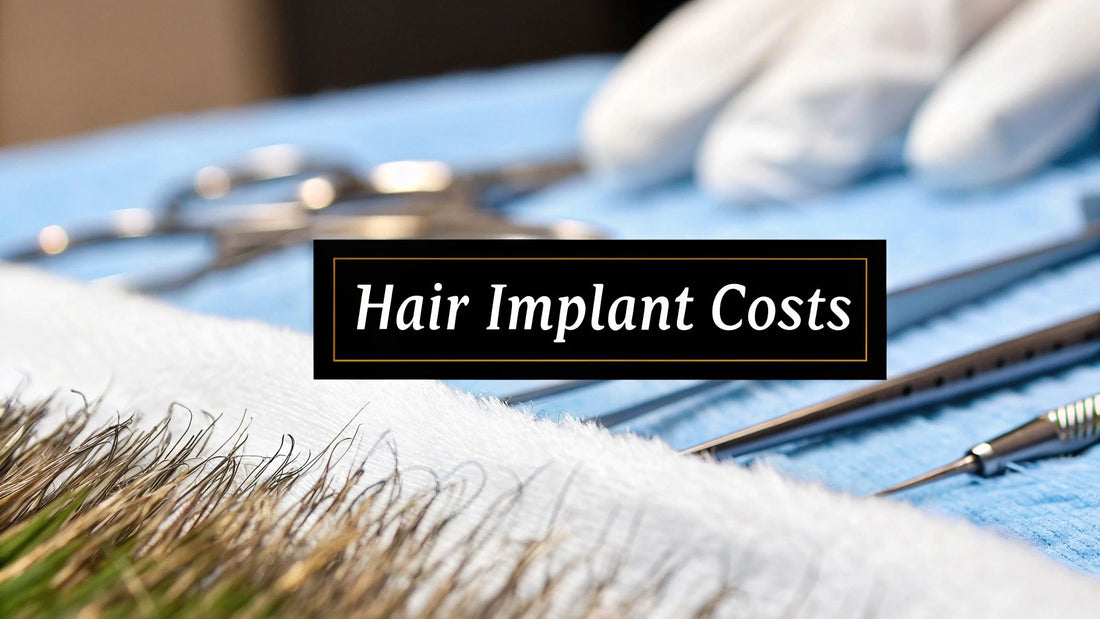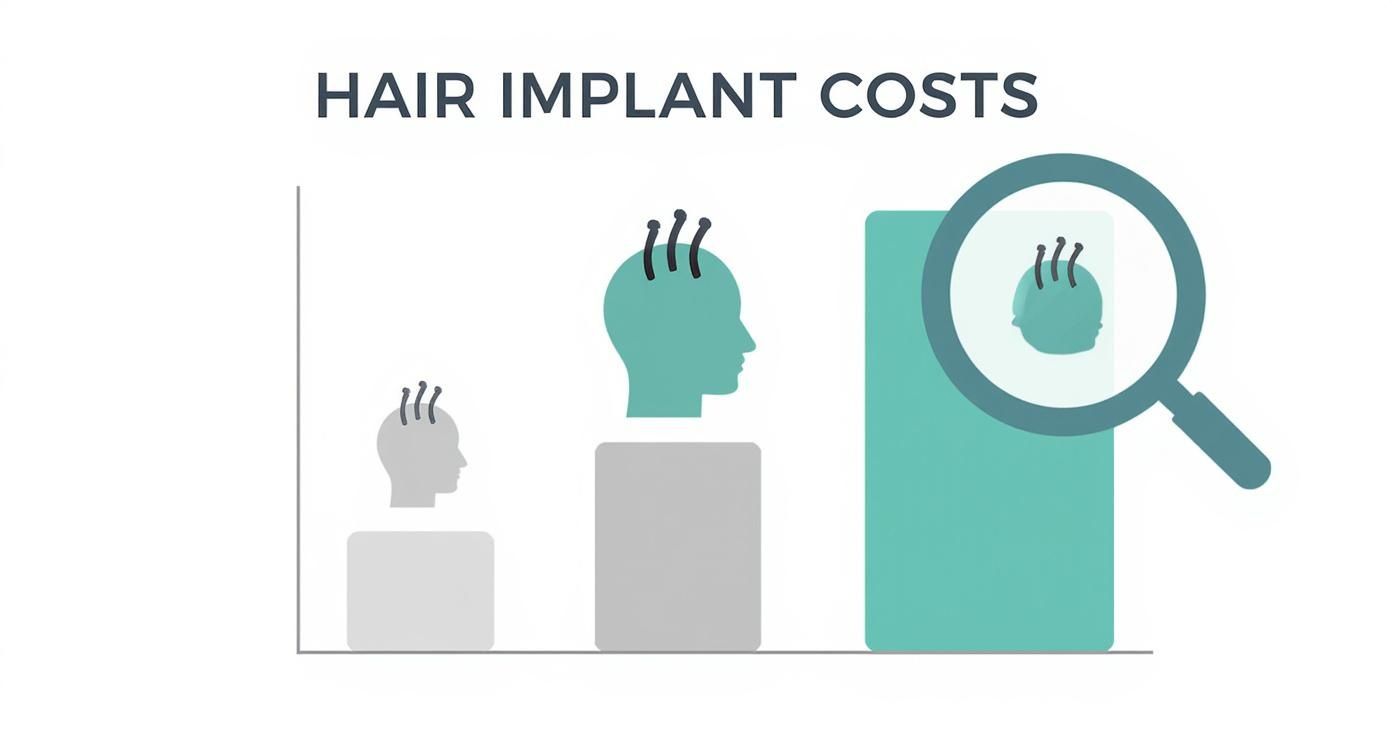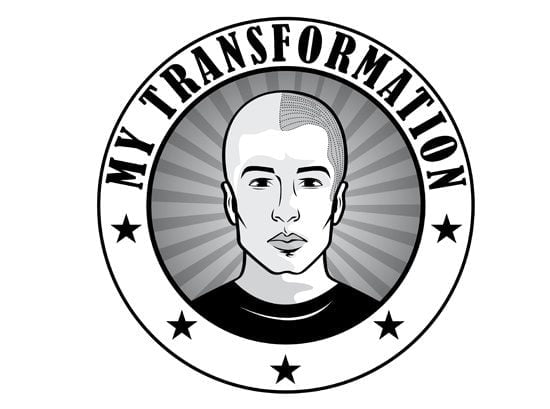
How Much Are Hair Implants? An Australian Cost Guide
Share
So, you're wondering how much hair implants actually cost in Australia? It's the number one question on everyone's mind. The short answer is that a procedure can run anywhere from $5,000 to well over $18,000, but the final figure really hinges on your specific situation—mainly, the extent of your hair loss and how many grafts you'll need.
It's best to think of it like a custom build. The final price tag is a direct reflection of your unique needs.
Your Quick Guide to Hair Implant Costs in Australia
Getting a handle on the potential investment is always the first step. The price isn't just a number plucked out of thin air; it’s calculated based on the precise number of hair follicles (or grafts) needed to get the density and coverage you're after.
A smaller session to touch up a receding hairline will obviously be much lighter on the wallet than a major procedure designed to address widespread thinning.
In Australia, the cost for both the popular Follicular Unit Extraction (FUE) and Follicular Unit Transplantation (FUT) methods scales up with the size of the session. Here's a general idea of what to expect:
- Smaller sessions (up to 600 grafts) often land somewhere between $5,000 and $6,500.
- Larger procedures (2,000 to 3,000 grafts) can cost anywhere from $14,000 to $18,000.
- Mega sessions (over 3,000 grafts) will typically start from $18,000 and go up from there, reflecting the intensive work required.
To get a feel for how this might apply to you, it's worth checking out some detailed pricing breakdowns from Australian clinics.
This handy table breaks down the typical price ranges you can expect to see across Australia based on the number of grafts.
| Graft Count | Procedure Size | Estimated Cost Range (AUD) |
|---|---|---|
| Up to 600 | Small (e.g., hairline touch-up) | $5,000 – $6,500 |
| 1,000–1,500 | Medium (e.g., temples, crown) | $8,000 – $12,000 |
| 2,000–3,000 | Large (e.g., significant coverage) | $14,000 – $18,000 |
| 3,000+ | Mega Session (e.g., extensive balding) | $18,000+ |
Of course, these are just ballpark figures. Your final quote will depend on the clinic, the surgeon's experience, and the specific technique used for your procedure.
The chart below gives you a clear visual on how the cost climbs as the procedure gets bigger and more complex.

As you can see, the investment ramps up quickly with the graft count. This really drives home why a one-on-one, personalised consultation is the only way to get a truly accurate quote for your hair restoration journey.
What Actually Determines the Price of Your Hair Transplant

Ever wondered why a friend got a quote for a hair transplant that was thousands of dollars different from yours? It’s a common question, and the answer isn't as simple as a flat fee. The final price is a careful calculation based on several key factors.
Think of it less like buying something off the shelf and more like commissioning a piece of custom art. You're not just paying for the hair; you're investing in a highly personalised medical procedure. The surgeon’s skill, the time involved, and the complexity of your specific case all play a huge part in the final figure. Let's break down what really moves the needle on cost.
The Technique Used
The surgical method chosen is one of the biggest drivers of the price. The two main techniques, Follicular Unit Transplantation (FUT) and Follicular Unit Extraction (FUE), demand different levels of precision and labour from the surgical team.
- FUT (The "Strip" Method): This is the more traditional approach. It involves removing a small strip of tissue from the back of the head (the donor area) to harvest the follicles. It's generally a faster procedure, which often makes it a less expensive option.
- FUE (Individual Extraction): The more modern technique involves extracting individual hair follicles, one by one. This is incredibly meticulous work that requires immense skill and patience from the surgeon, making it more time-consuming and, as a result, more costly.
Each method has its pros and cons. You can dive deeper into the specifics of an FUE hair transplant to see how it works. The choice of technique has a direct impact on the surgeon's time, the technology used, and the overall cost.
The Number of Grafts
This one is pretty straightforward: the more hair you need, the more it will cost. Restoring a slightly receding hairline will require far fewer grafts than providing full coverage for a significantly bald crown. It’s a simple matter of time and resources.
During your consultation, this is where you'll get real clarity. The surgeon will assess your level of hair loss—often using a guide like the Norwood scale for men—to give you an accurate estimate of the graft count needed to achieve a full, natural-looking result.
The Surgeon's Expertise
Finally, and perhaps most importantly, is the experience and reputation of your surgeon. A world-class surgeon with a long history of creating incredible, natural-looking results is going to command a higher fee. And for good reason.
This premium isn't just for a name. It reflects their refined skill, their artistic eye for creating a flattering hairline, and the quality of their entire clinical team and facility. Essentially, you're paying for their expertise and the peace of mind that comes from knowing you’re in the best possible hands.
How Location Impacts Hair Implant Costs in Australia

So, does it really matter where you get your hair transplant? You bet it does. Think of it like real estate—a clinic in the middle of Sydney or Melbourne is almost guaranteed to have a higher price tag than one in a smaller city.
It's not just about paying for a fancy address. Clinics in major metro areas are dealing with much higher overheads. Everything from rent and staff wages to general business expenses costs more, and those costs are inevitably built into the final price you pay.
Plus, with more people seeking procedures in big cities, the simple rule of supply and demand allows top-tier clinics to charge a premium for their expertise.
A Look at Sydney Prices
Let’s zero in on Sydney to see how this plays out in the real world. As one of Australia's biggest hubs for cosmetic procedures, its pricing gives us a solid benchmark for what you can expect in a premium market.
Right now, an average procedure can set you back anywhere from AUD 5,000 to 15,000. If you're leaning towards the FUE method, you're likely looking at a range of AUD 8,000 to 15,000, while the FUT technique often comes in a bit lower, between AUD 4,000 and 10,000.
Some clinics even offer packages, like a 3,500-graft procedure starting around the AUD 10,000 mark, so it really pays to do your homework. Digging into the specifics of hair transplant costs in Sydney can give you an even clearer picture.
This is exactly why it’s a smart move to compare clinics in different cities. For example, you might want to look into the hair transplant cost in Perth to see how prices stack up across the country.
Key Takeaway: Your postcode has a direct impact on the cost of your hair transplant. Taking the time to research clinics not just in your city but in neighbouring ones is a crucial step in setting a realistic budget for your hair restoration journey.
So, you're looking into a hair transplant and have seen the prices here in Australia. It's only natural to wonder how our local costs compare to what's being offered overseas. Getting a bird's-eye view of the global market is a smart move—it helps you figure out if you're getting good value and what your money is actually paying for.
When you start comparing, you'll quickly see that Australia sits at the higher end of the pricing spectrum, much like the United States and Canada. This can come as a bit of a shock, especially when you see ads for procedures in places like Turkey for a fraction of the price. The cost difference is massive, and it begs the question: what's behind that huge price gap?
Why Australian Clinics Cost More
That higher price tag isn't just a number plucked out of thin air. It’s a direct reflection of Australia's incredibly high medical standards, regulatory oversight, and the general costs of running a top-tier clinic here.
Let's look at the numbers. A global cost comparison puts the average hair transplant in Australia at around AUD 19,500. In a popular medical tourism spot like Turkey, you might see prices hovering around AUD 4,000. For a deeper dive into these figures, you can see more data on global hair transplant costs at Acibadem Beauty Center.
So, what's driving this difference? It really boils down to a few key things:
- Strict Medical Regulations: Australia has some of the toughest medical standards in the world. This isn't a bad thing; it's there to protect you.
- Expert Surgeons & Staff: You’re paying for the deep expertise of highly qualified surgeons and a professional clinical team who are all paid local wages.
- Cutting-Edge Tech: Top Aussie clinics invest heavily in the latest FUE or DHI technology and maintain pristine, modern facilities.
The Bottom Line: While going overseas looks tempting on paper, the price in Australia is buying you something invaluable: peace of mind. You're paying for safety, quality, and the assurance that your surgeon is accountable and held to world-class standards.
To give you a clearer picture, let's break down how the costs stack up in a few key countries.
Global Hair Implant Cost Comparison (Average Procedure)
| Country | Average Cost (AUD) | Key Considerations |
|---|---|---|
| Australia | $13,000 - $25,000+ | High medical standards, expert surgeons, local follow-up care. |
| United States | $15,000 - $30,000+ | Very similar to Australia in terms of quality and cost, with regional price variations. |
| United Kingdom | $10,000 - $20,000 | Strong regulations, but costs can still vary significantly between major cities. |
| Thailand | $6,000 - $12,000 | A popular medical tourism spot, but quality and standards can be inconsistent. |
| Turkey | $4,000 - $8,000 | The budget option. Known for "hair mills" with a high risk of poor results or complications. |
As you can see, the price difference is significant, but so are the risks. Choosing a local clinic means you have access to your surgeon for follow-up appointments and a clear path for recourse if anything doesn't go to plan.
Of course, surgery isn't the only path. If you're weighing up all your options, it’s worth understanding how SMP compares to other hair restoration methods as well. In the end, it’s about balancing the initial financial outlay with the long-term value and security that comes with local, expert care.
Smart Financial Planning for Your Hair Transplant
Getting a handle on how much hair implants cost is the first big hurdle. The next, of course, is figuring out how to actually pay for it.
Because hair transplants are considered a cosmetic procedure, you'll find that Medicare and private health insurance almost never cover them. This means the investment is one you'll need to fund yourself.
So, how do you tackle a big expense like this? Many people start by simply putting money aside in a dedicated savings account. It’s a classic for a reason. You can set up an automatic transfer every payday, which helps you slowly build up the funds without feeling a huge hit to your wallet.
But saving up the entire amount isn't your only option. Many clinics understand this is a significant outlay and have put systems in place to make it more manageable.
Exploring Your Payment Options
When you go in for a consultation, don't be shy about digging into the payment details. Good clinics expect these questions and often have flexible solutions to help make the procedure more accessible.
You'll usually find a couple of common pathways:
- In-House Payment Plans: Some clinics offer their own plans, letting you spread the cost over a few months directly with them.
- Third-Party Medical Financing: It’s also common for clinics to partner with specialised finance companies that provide loans specifically for medical and cosmetic treatments.
It’s definitely worth exploring the different hair transplant payment plans out there to see what works for your budget. Just make sure you get all the details – like interest rates or any extra fees – so you can make a clear-headed decision.
Here's a pro-tip I always give my clients: never, ever choose a clinic just because they offer a payment plan. Your top priority should always be the surgeon’s skill and the clinic's track record. Once you've found the right fit, then you can talk money. This way, you're investing in a quality result, not just a convenient payment schedule.
Common Questions About Hair Implant Costs

Even after you've crunched the numbers, a few big questions tend to surface when you start seriously considering a hair transplant. Getting straight answers is the only way to feel confident about moving forward. Let's dig into the most common ones.
Is a More Expensive Transplant Always Better?
Not always. While a higher price can sometimes signal a surgeon’s deep experience or the use of top-tier technology, the real goal is to find the best value, not just the biggest price tag.
A surgeon's credentials, genuine patient reviews, and a solid portfolio of before-and-after photos are much more reliable indicators of quality than the cost alone. The "best" procedure is the one performed by a highly skilled, reputable surgeon who gives you safe, natural-looking results. Focus on their track record first.
Are There Any Hidden Costs I Should Know About?
A good clinic will be totally upfront about pricing. But it’s still on you to be proactive. Always ask for a fully itemised, written quote before you agree to anything.
This quote should spell out exactly what you're paying for. Make sure to double-check if the final price covers all the essentials:
- Pre-operative consultations
- Any post-operative care kits or medications
- All your follow-up appointments
Getting that all-inclusive quote is your best defence against any nasty surprises down the road.
Scarring is one area people often have questions about. While modern FUE techniques are designed to minimise visible marks, they aren't entirely scar-free. It's vital to understand the reality of a hair implant scar and how it’s managed as part of your recovery.
Why Does the Cost Per Graft Differ So Much Between Clinics?
The price per graft isn't just for the hair follicle; it reflects the entire service you're receiving. A world-renowned surgeon with a decade of proven success will naturally charge more than a doctor who is newer to the field.
Think about what else goes into that price: the sophistication of the equipment, the size and skill of the clinical team supporting the surgeon, and the level of personalised care you get from start to finish. You’re not just buying hairs; you’re investing in a comprehensive medical experience.
Can I Use Medicare or Private Health Insurance?
Unfortunately, in nearly every case here in Australia, the answer is no. Hair transplants are considered a cosmetic procedure, so they aren't covered by Medicare or standard private health insurance plans.
You really need to plan for this as a full out-of-pocket expense. The only rare exceptions might be for hair loss caused by a documented medical condition or severe trauma, but getting that approved is incredibly difficult and requires a mountain of paperwork.
At My Transformation, we're all about giving you clear, honest guidance for your hair loss journey. If you're exploring a non-surgical option that delivers fantastic, realistic results, check out our scalp micropigmentation services at https://www.mytransformation.com.au.
